the below text is taken from the architects’ journal january 2023 building study
Fran Williams visits Crusader and Phoenix, shedkm’s regeneration of several 1840s Manchester cotton mill buildings to deliver a residential community set around a landscaped courtyard.
Some of you may remember the 2020 BBC Two documentary Manctopia: Billion Pound Property Boom. The four-part series documented the massive ongoing redevelopment of Manchester city centre, where the population had doubled to over 60,000 (as of two years ago) since 2014 when the then chancellor George Osborne announced his ‘northern powerhouse’ plan. The programme detailed the city council’s focus on building market homes, turning swathes of wasteland into clusters of high-rise apartment blocks while razing pockets of still-affordable housing in the process, and highlighted the fast-moving effects of gentrification and transition in the city.
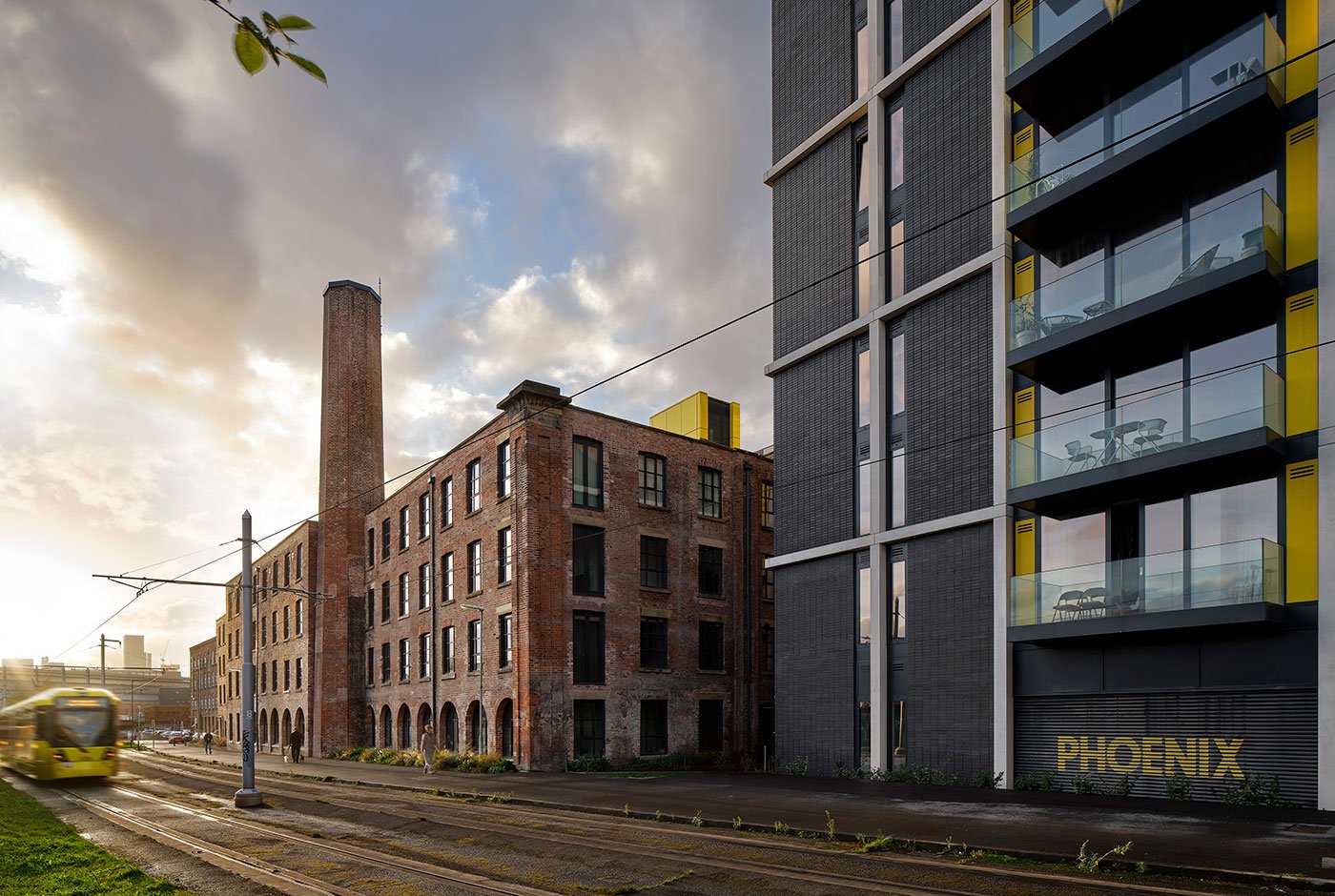
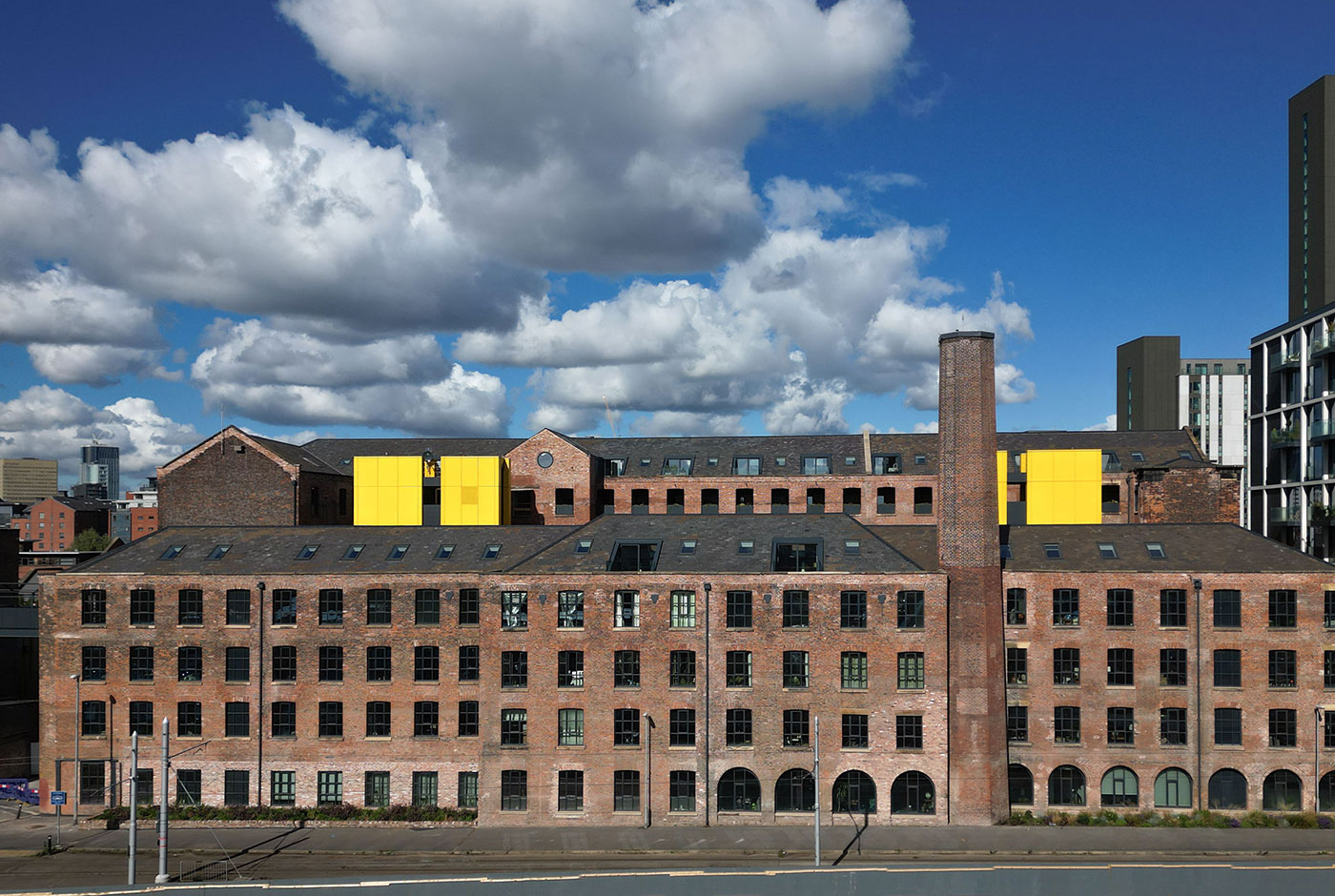
Capital&Centric (C&C) was among names from the development world featured, having backed several large schemes in the city, including a previous conversion by shedkm of Talbot Mill on Worsley Street into flats – one of many projects that the London and Liverpool-based practice has completed in Manchester.
shedkm’s latest completed housing project working with C&C also featured on the BBC series. Crusader Works comprises two elements: Crusader (a retrofit) and Phoenix (new build). I meet the practice’s director Mark Sidebotham and architect Leonora Aigbokhae, as well as C&C development manager Emma Cooper on site at the Grade II Listed Crusader Mill conversion in an area of Manchester now known as Piccadilly East, on a crisp December day. The sun is low and there is an orangey glow to the development’s historic brickwork.
Originally known as the Phoenix Works, the huge factory – now Crusader – once included an iron foundry on the opposite side of Chapeltown Street, just minutes north of Manchester Piccadilly Station. The mill was among the earliest purpose-built textile machinery works in the city, once part of Manchester’s ‘Cottonopolis’. It was built in the 1840s by Parr, Curtis and Madeley, then destroyed by fire in 1861, having to be rebuilt.
John Hetherington & Sons, another leading textile machinery manufacturer, continued to use the mill until the early 1920s when the industry went into decline. The buildings were subsequently listed in 1994 for being a rare example of a large, mid-19th century works, crucial to the success of the city’s cotton industry.
The conversion of the Listed shell to flats has been approximately eight years in the making. The 10,200m2 development now consists of 123 flats in the existing Crusader, anchored around a landscaped communal courtyard, alongside 75 dwellings in adjacent new-build Phoenix. All the homes are for market sale.
Crusader is one of five mills in Manchester that C&C is breathing new life into, and marks a 12-year relationship with shedkm. In addition to Talbot Mill, the two have already worked on the £250 million Kampus development alongside joint venture partner Henry Boot Developments. Ferrous, planned for an empty patch of land next to Phoenix on Chapeltown Street is also in the works; and six years ago, shedkm designed C&C’s Liverpool offices – aptly named Bunker.
Prior to regeneration, Crusader was a collection of dilapidated buildings. At some point, someone decided that the original history of the building was more important than anything else – although its listing meant demolition was never really an option.
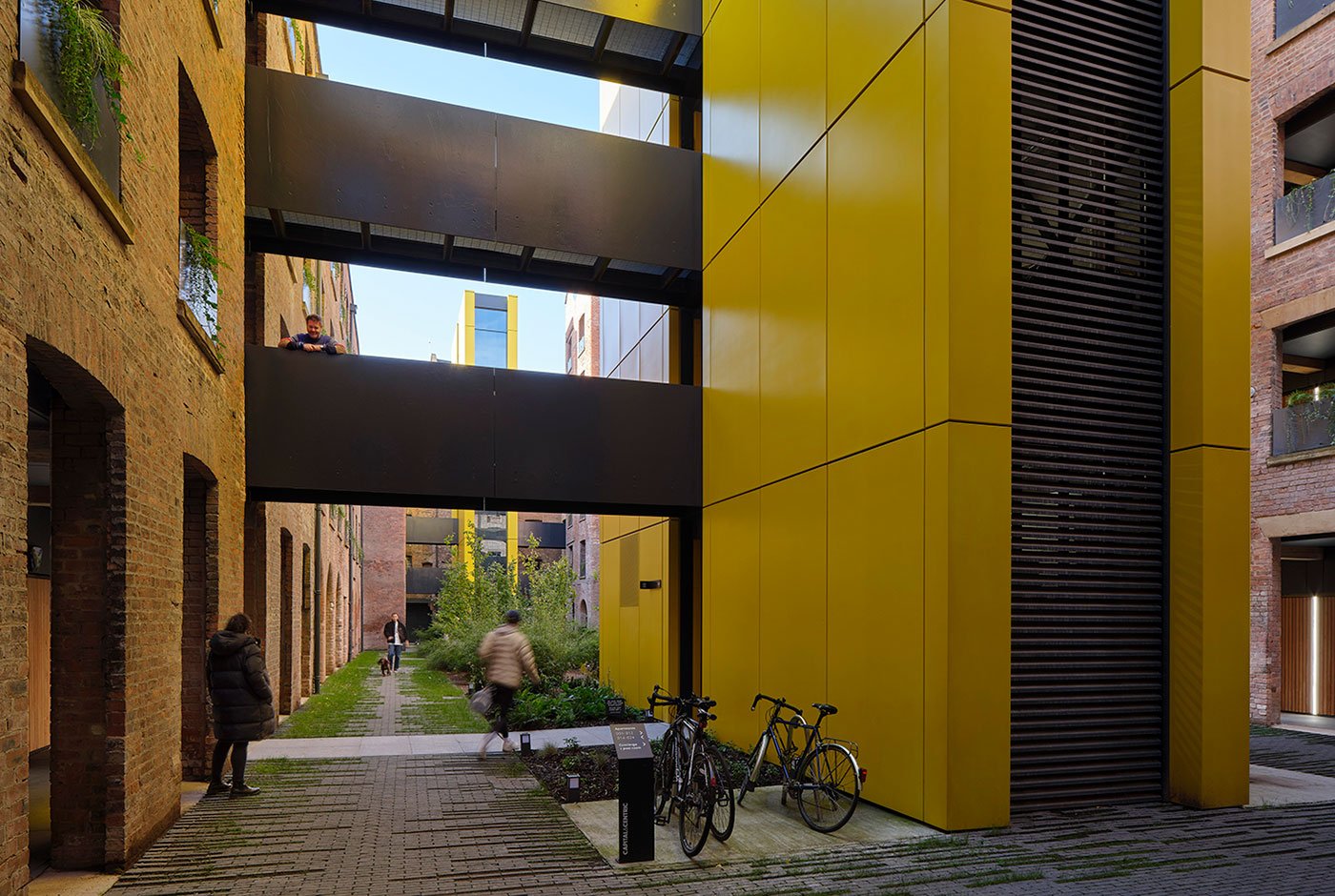
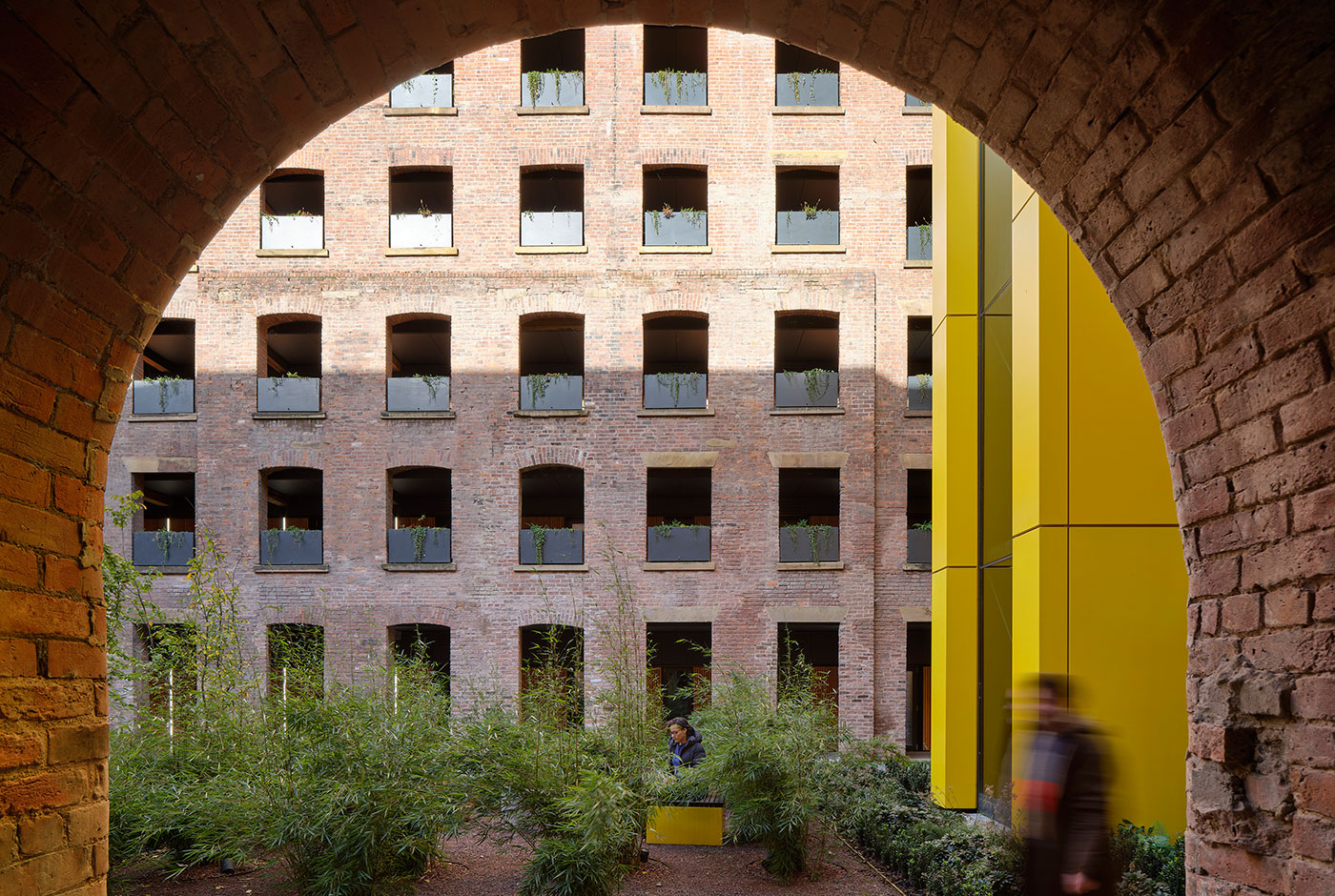
Crusader’s architectural interest is evident and lies in its existing collection of buildings, scale, industrial character and aesthetic composition of the repetitious bays and windows, which shedkm has relatively sensitively restored, preserving and enhancing its best features. The courtyard enclosure has been restored with original masonry, timber structures and industrial elements retained, ensuring the historic form of the building complex remains legible.
The scheme is approached through this communal courtyard, where a cloistered walkway has been introduced to the façades that flank it. Apartments line the outer façades of each of the four connected mill buildings while the cloister attaches to the circulation cores within the courtyard.
The courtyard, once full of waste and mud, is now conceived as a transitional space; a calming landscaped garden full of complementary planting and hidden benches. It includes communal barbecues, firepits, cycle facilities and, apparently, Wi-Fi.
An external circulation strategy, designed by shedkm to have minimal impact on the Listed façades, unites the four existing buildings around the landscaped garden. Excitingly bold, yellow circulation and amenity cores, described as ‘modern insertions’, have been placed within these almost Lego-like blocks. These branch out to the existing structures, creating a strong contrast between old and new, and animating and warming the historic masonry. Glazed lift cores and metal-gridded bridges link the buildings vertically and horizontally while also creating views down to the courtyard while en route to one’s flat.
Yellow – 1023 RAL Traffic Yellow to be precise – is the colour that shedkm has chosen here as a key part of the practice’s visual identity. ‘It has been our colour since day one,’ says Sidebotham. ‘We like the warmth of it,’ adds Aigbokhae.
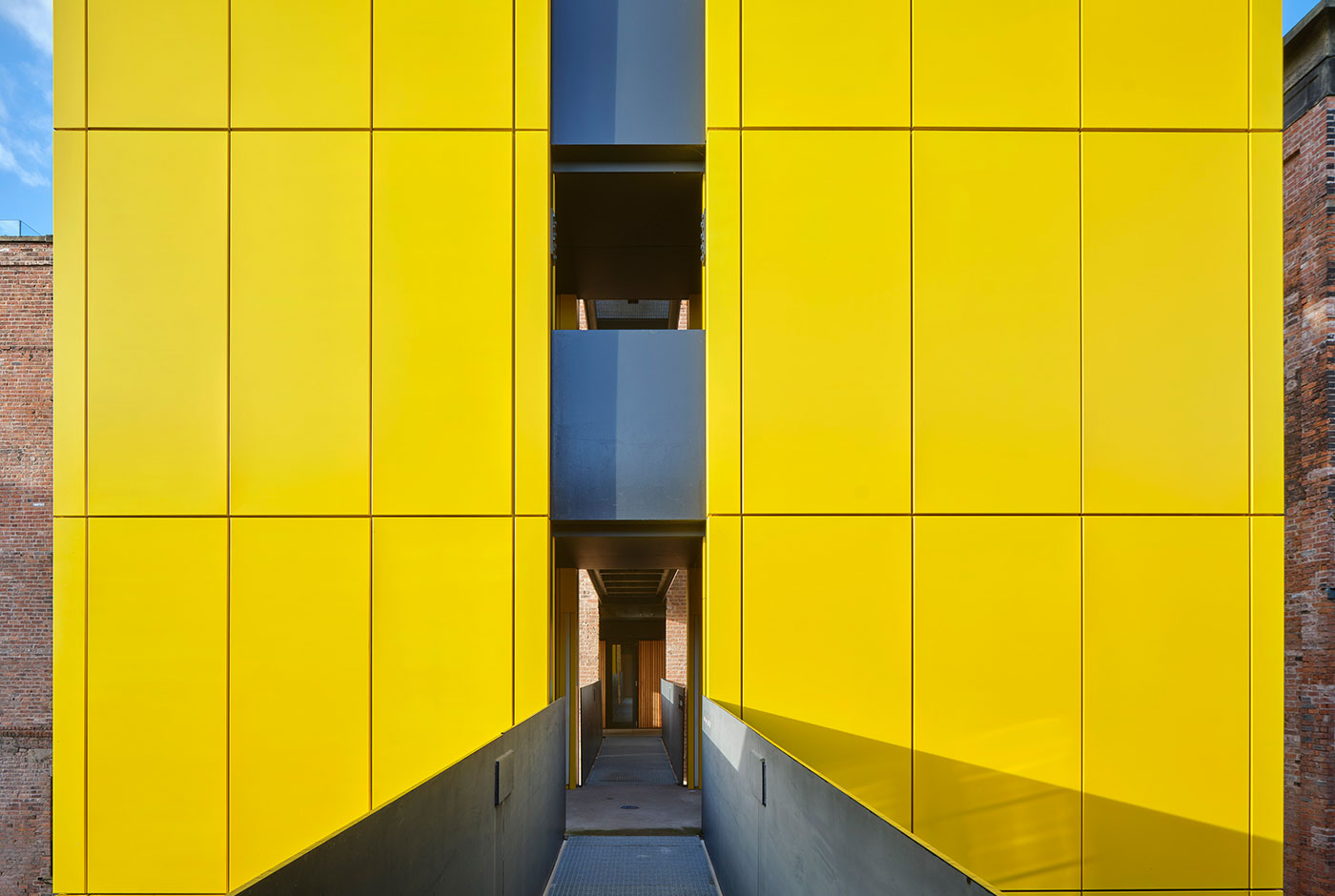
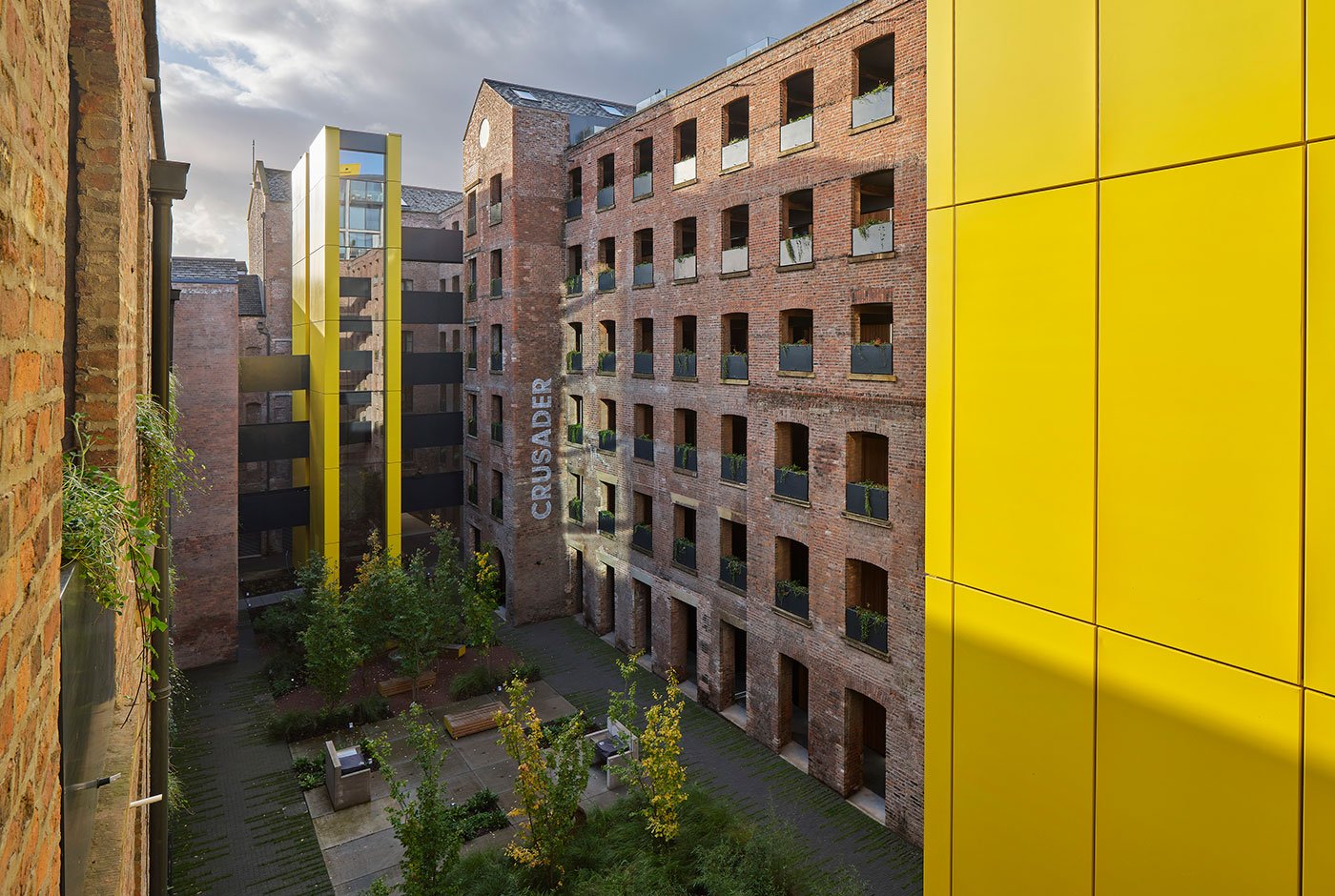
The choice isn’t imaginative – more about practice branding than choosing a colour appropriate for the scheme – but at the end of the day, I also love yellow (who doesn’t?) so perhaps it has worked out. In bright winter sunlight, the yellow enamelled cores work well as a tool to reflect light into the darker corners of the bricky scheme, sending a photogenic golden hue over the whole.
To retain the existing brickwork where possible, shedkm has introduced an insulated cloister wall to form the inner apartment façade – compensating for the retention of the existing exposed brickwork – and meaning each flat is essentially accessed off an inward-looking deck. Integration of existing fabric elements has also driven the material language of the scheme; original doors and stairs have been retained and re-used where possible. The stairs are worn from years of use, reminding one of the layers of history there.
Robust, hard-wearing materials have been adopted throughout to help reduce ongoing maintenance and energy use, reinforcing a semi-industrial aesthetic. Local labour and suppliers were employed during the construction stages of the scheme.
Working with a Listed historic mill obviously isn’t easy. Neither is converting one into residential, and here shedkm should be commended. There were ‘lots of structural gymnastics involved’, says Aigbokhae. The floor levels had to be raised within the building and structures left exposed where possible, meaning lots of tricky and bespoke joints. It’s not consistent throughout, but that just adds to the charm of the scheme.
The building’s exterior brickwork has had a light cleaning job. Aigbokhae and Sidebotham point out that ‘where you could fit a tennis ball in’, they’ve replaced the gap with a brick. Where timber beams needed strengthening, metal plates have been put in place, keeping the style of the scheme as industrial as possible. They describe the minor alterations as ‘making good’. Essentially all external walls are original while internal ones are mostly new build.
The 123 one and two-bed ‘loft’ apartments in Crusader range in size from 47.7m2 to 110m2. Bedrooms and bathrooms look on to the courtyard while living spaces look outwards, providing more value for the client. Each flat is unique owing to the historic nature and features of the existing. Upper-level duplex apartments benefit from south-facing roof terraces. These are low-profile interventions, set back to preserve the existing roofline and provide a sense of privacy.
I visit two show apartments. The first is a two-bed, which I’m told is being bought by an influencer. It has exposed brickwork throughout, edgy warehouse-style. The existing timber trusses from the mill have been left exposed. This is unusual for a developer-led scheme and gives a sort of French farmhouse/holiday home vibe to the spacious bedrooms.
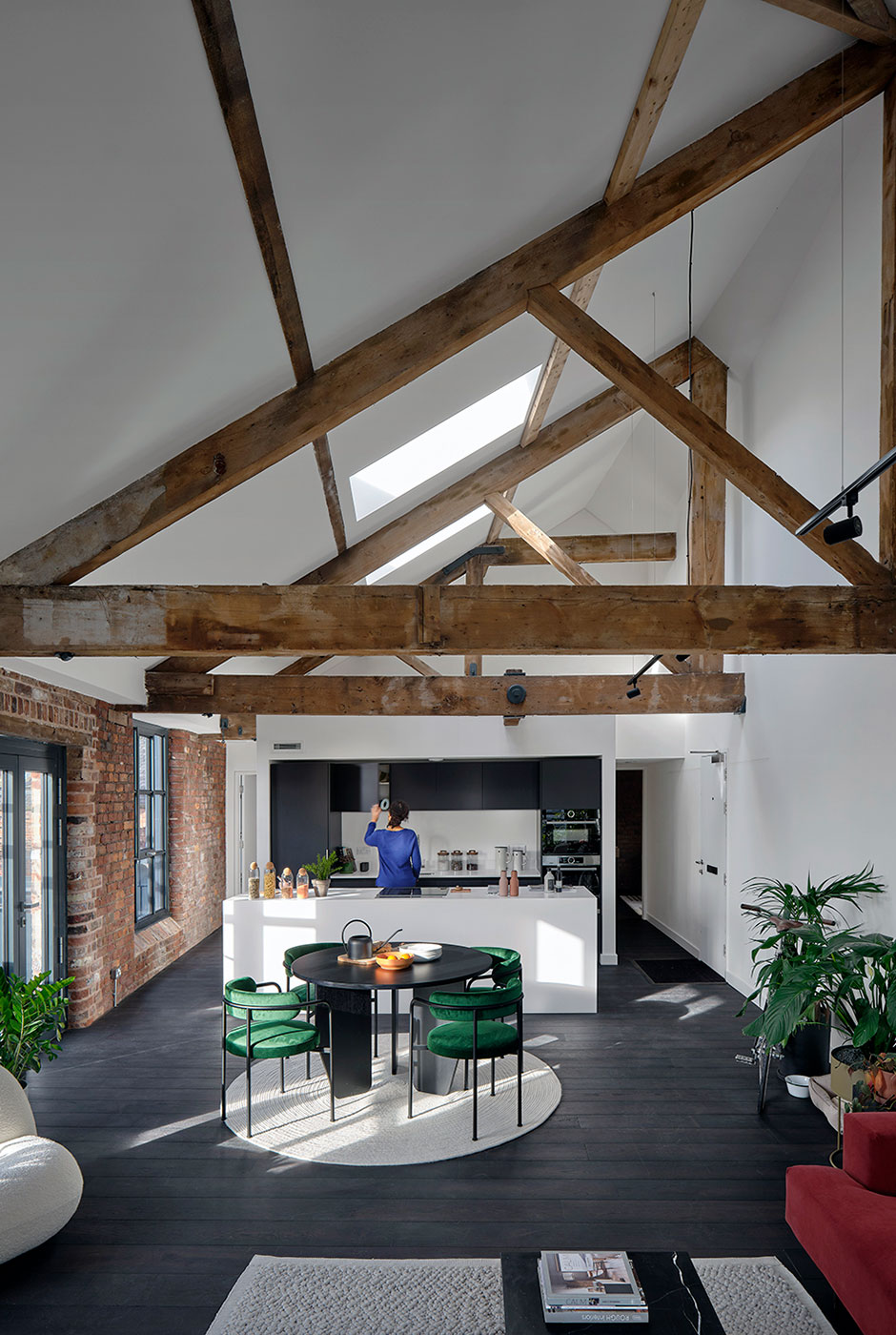
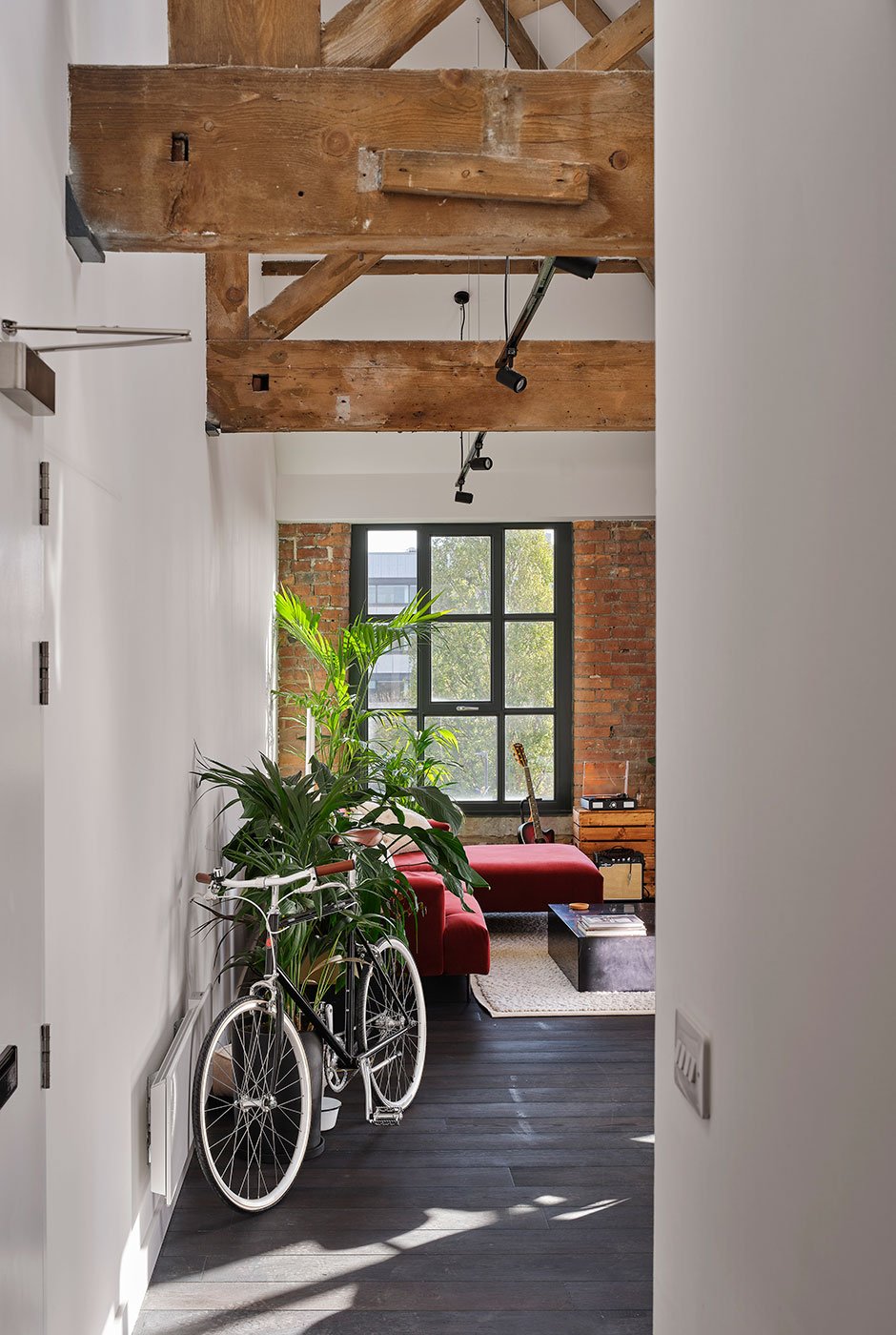
The kitchen unit creates an ‘object’ at the centre of the flat, which shedkm says is consistent in their designs for every residential project they work on. It’s an efficient way of routing all the wet ‘stuff’ and servicing through the centre of the apartment. Acoustically and in terms of thermal comfort, each apartment is high performing. You can’t hear a thing between party walls and the flat feels peaceful and private despite its proximity to Piccadilly station. In this corner flat, the balcony is formed from an existing metal link connected to an old office building that once serviced the mill. This adjacent building is to become C&C’s offices.
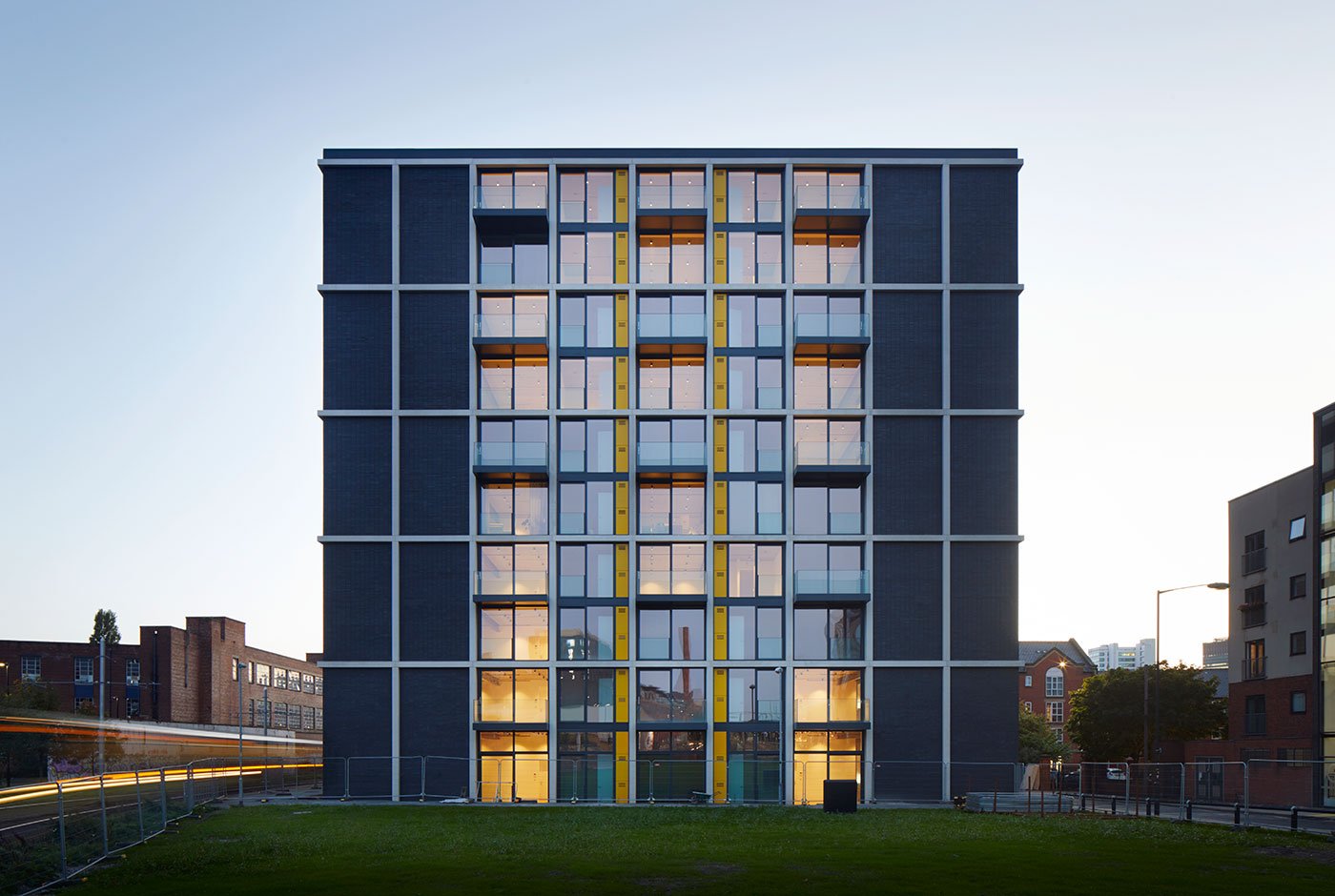
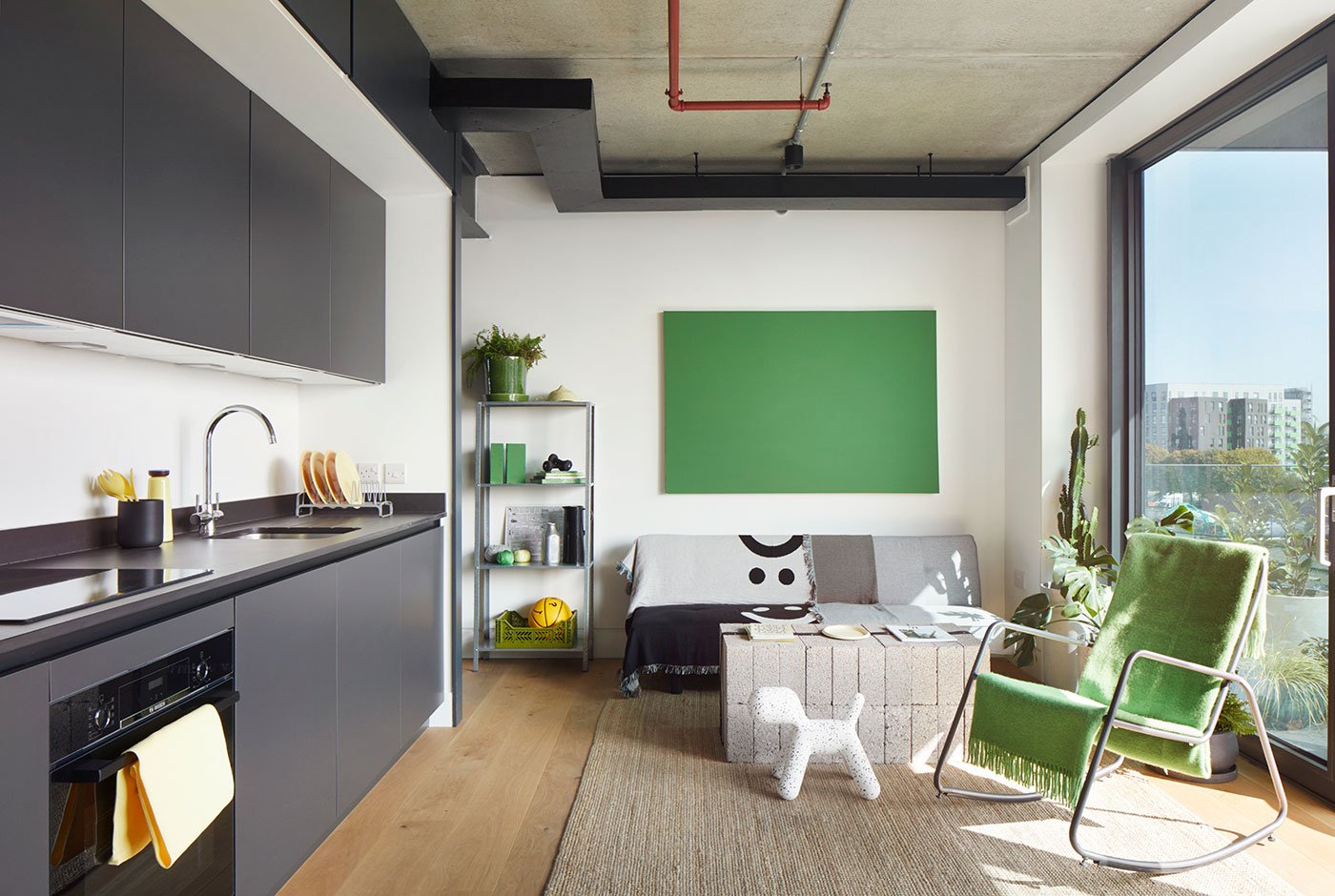
On the plot next door, a three-storey contemporary glass building has been replaced with Phoenix, an 80s-looking 10-storey block which, says Cooper, ‘finishes the street’. Again, it is made up of one and two-bed flats, designed to help generate income for the rest of the development. Continuing the industrial aesthetic, each open-plan flat has exposed concrete ceilings, steel and pipework. Externally, the façade consists of a precast concrete frame tied back to the internal steel frame, the concrete itself holding the masonry of the cladding with bolt-on balconies on two sides. The flat roofscape is defined by the projecting yellow cores that rise above the centre of the plan. Inside, it’s a very simply laid out block. Two cores with three or four flats per floor and again, the kitchen forms a serviced object within each.
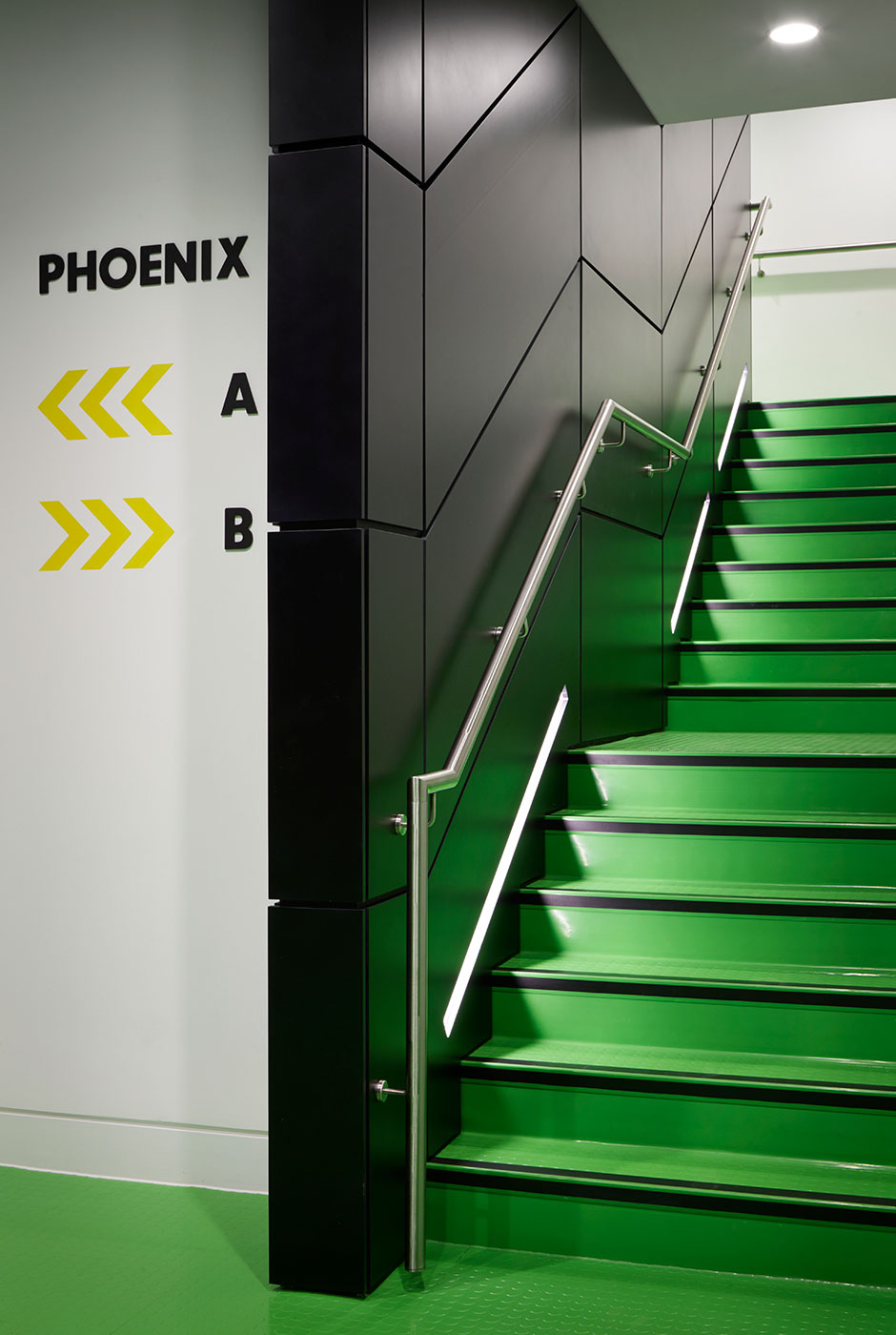
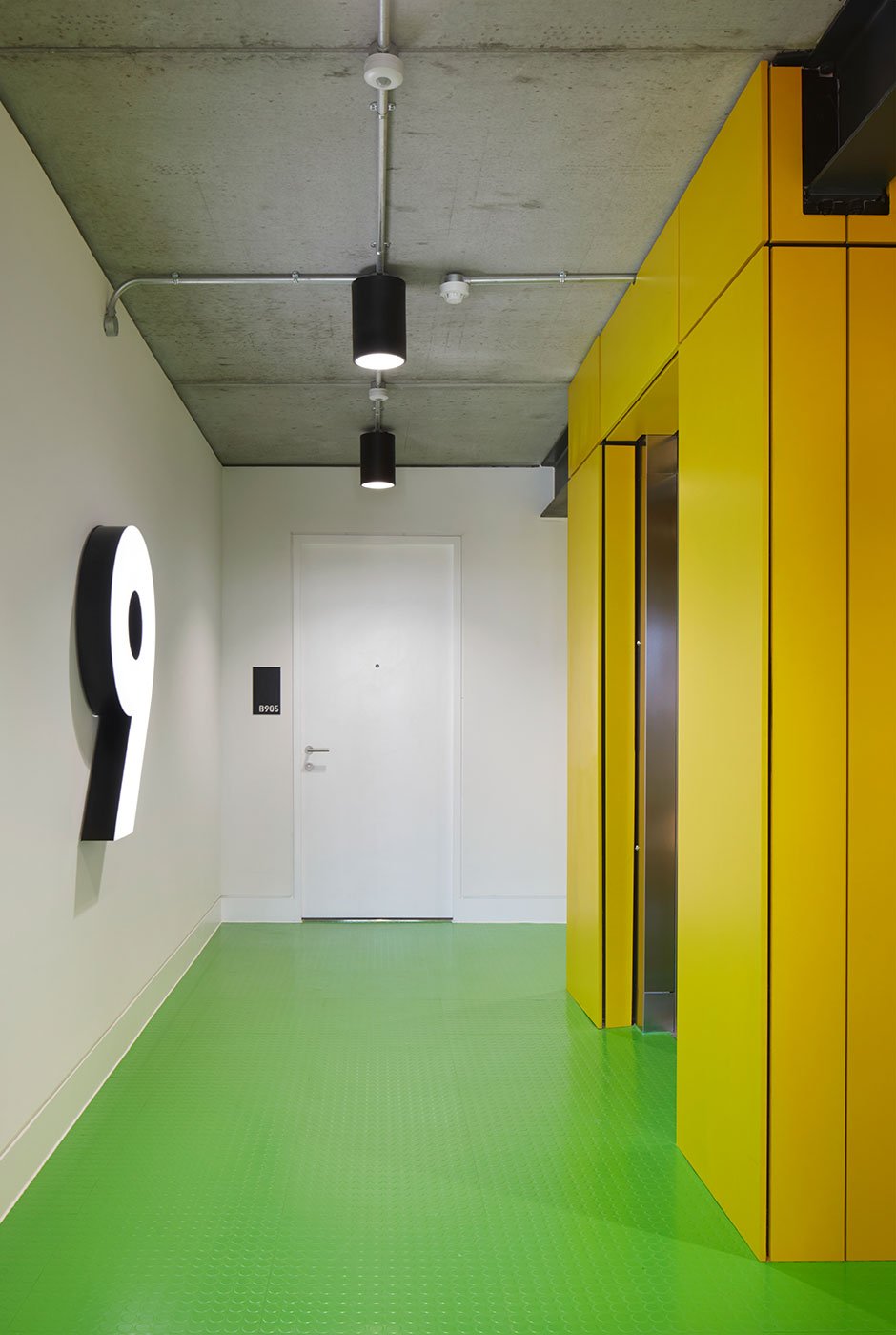
According to C&C, zero value engineering took place within Crusader and Phoenix, the lack of short cuts meaning the project took longer than typically expected. Construction was also held up on Crusader by the contractor working on the project going into administration and, of course, the pandemic.
Overall the aesthetic throughout the entire Crusader Works scheme is pleasant, if perhaps veering too much towards current trends; most likely aimed at the young professional/millennial buyers and what one would typically expect to see in Manchester city centre. There are no investors allowed, according to C&C, and homes were offered to locals first to cultivate an owner-occupier community – a tiny step in the right direction when the developer could have easily prioritised profit margins. Prices for the remaining apartments range upwards from £365,000 (when first launched a one-bed started from £195,000) – disappointingly not factoring affordable in at all – which will likely make for a fairly undiverse demographic. This, combined with its pointed aesthetics, makes the scheme feel almost too curated.
‘The area is changing rapidly,’ says Cooper, hinting at the obvious effects of gentrification within Piccadilly East. One remnant of what was here before is a lone Chinese seafood specialist, taking up a warehouse on the site. There is not a great deal of amenity nearby though, despite the site’s proximity to the station, and the nearest walkable areas to go to are Ancoats and the Northern Quarter.
Although the scheme isn’t solving any of Manchester’s affordable housing problems, it is a well-designed and completed project, making something beautiful out of an underused historical artefact. If that is one outcome of re-using our building stock and crucial elements of the UK’s redundant industrial history to create much-needed housing (even if it doesn’t fulfil an affordable quota), then perhaps it is worth it.
architect’s view
The initial space planning studies looked to use all the existing structures, however the opportunity to replace the unlisted mill structure with a more efficient new build gave a balance to the project appraisal which would facilitate the regeneration of the dilapidated Listed buildings and make the overall scheme viable.
The circulation strategy for Crusader uses a cloister typology. This generates a number of advantages, including dual-aspect apartments, bedrooms located on quieter zones and activated courtyard façades. The external envelope is enhanced by the new courtyard façade, which allows more exposure of the original listed building brickwork. Similarly, locating the new cores within the courtyard rather than within the existing building generates increased net area, separates the living accommodation from the lifts and refuse stores and is less destructive to the original listed structure.
Thus the combination of the new cores located within the landscaped courtyard and the cloister circulation affording views into the courtyard celebrates the journey for the resident from the pavement to the front door, in contrast to a traditional internalised route.
The primary steel frame to the Phoenix new build carries the building in a traditional way, however the expressed precast concrete frame carries the vertical load of the brickwork thus significantly reducing the weight of the steel frame.
Mark Sidebotham, Director, shedkm
landscape architect’s view
The brief for the landscape at Crusader Works was to transform the courtyard into a green oasis while creating a series of flexible social spaces for use by the new community. Shedkm’s proposals for the building, setting the apartments back from the courtyard wall and creating cloisters, were part of the inspiration for the design language that developed for the landscape.
The ideas of sanctuary, rhythm and formality that are prevalent in the hortus conclusus of abbeys and monasteries, were taken forward and playfully overlaid with a materials palette that responded to the industrial heritage of the building. Robust materials, including Cor-ten steel edges and large-format concrete slabs, were used to define the series of routes and dwell spaces that fill the courtyard and building surrounds.
To soften this, abundant planting was introduced throughout the scheme. Tree planting comprises a grove of multi-stemmed Persian ironwoods (parrotia persica) complemented by ground cover planting that draws inspiration from the self-seeded plants found growing in cracks and crevices in the pre-restored mill.
In order to maximise the areas of planting, the boundaries between hard and soft landscape have been blurred, resulting in the grass creeping through the paving, and trailing plants cascading from the window boxes that are within the cloisters on each level. This reinforces the courtyard as a place to escape the city and a garden for the residents. Communal seating, fire pits and barbecues allow the community at Crusader Works to mix and socialise in their garden space.
Shaun Lyons, Associate Landscape Architect, Exterior Architecture
client’s view
A big part of the brief at Crusader Works was to retain and respect as many of the mill’s stunning original features as we could while elevating their beauty at every turn.
The response was a perfect harmony between old and new – the imposing brick walls around the internal cloister providing a stunning backdrop to the new, vivid yellow lift shafts, resident walkways, and hidden garden (once a car park).
There’s so much focus on new builds achieving sustainability standards, but we’re massive retrofit advocates. Repurposing historic buildings is not only essential in maintaining the social heritage of a city, it also needs to be part of the national sustainability story. Converting Crusader has saved over 2,400 tonnes of embodied carbon – the equivalent of around 20 million car miles. The design also minimises operational carbon, with the open cloisters and resident courtyard meaning no heating is required for the common spaces. All circulation spaces are finished in hard wearing, easy-to-clean floor finishes, avoiding the need to replace carpets. The generously planted garden and planters provide opportunities for increased biodiversity that were previously non-existent.
Part of the challenge for us and shedkm was to create spaces where people were drawn to be part of a community, even though the area was rough around the edges at the time. We both really had to do a lot of heavy lifting to convince people Piccadilly East was the place to be, a lot of that was down to the appeal of the design and architectural merit, and the respect it showed the industrial nature of the area.
Adam Higgins, co-founder, Capital&Centric
crusader works – cloisters
The key strategy for the scheme was to place bold circulation and amenity cores within the courtyard, branching out to the existing buildings and creating cloistered walkways set back from the existing façade. Whereas standard layout solutions for apartment typologies use a central corridor with single-aspect apartments, the cloister and courtyard configuration provide a dual aspect to all apartments affording better lighting and cross ventilation opportunities.
A fabric first approach was adopted in line with retaining existing brickwork wherever possible. Introducing a new insulated cloister wall to form the inner apartment façade compensates for the retention of the existing exposed brickwork. This is formed with a timber frame and supporting steel structure, with larch cladding with a cementitious board frieze at high level. Door and window openings are framed with aluminium trims and recessed lighting sits within the cladding zone. The raised cloister floor (tile and pedestal system) allows services to be concealed within the void with minimal intervention to the existing building.
Planter boxes (aluminium with steel framing) sit within each of the openings to the existing masonry façade. These are side bolted to the masonry, providing balustrade protection.
The existing timber beams are exposed throughout the scheme, with cementitious board soffits.
Leonora Aigbokhae, Architect, shedkm
crusader works – roof terrace
Duplex apartments are located on the upper two levels of each of the main mill buildings. These apartments make the most of the extended height in the roof space and the existing timber structure. The living and kitchen spaces are located on the upper level while roof terraces provide residents with tucked-in private amenity spaces, offering views over Manchester’s skyline towards the Peak District. The terraces are formed as recessive cut-outs, sitting within the roof line so as to have minimal visual impact on the overall form. The terrace opening is formed with a steel ‘goalpost’ that spans between the existing timber trusses and supports the existing roof.
Sliding doors lead from the living space on to the terrace, which has a tiled deck floor. With simple frameless glass balustrades and dark grey aluminium cladding, the terraces disappear in the roof line.
Leonora Aigbokhae, Architect, shedkm
phoenix detail
The building is constructed of an external precast concrete frame strapped back to a primary steel frame with exposed precast concrete deck. This contains double-storey panels of grey, stack bonded brickwork, supported by the external concrete frame, interspersed with full-height windows and columns of coloured panels that relate to the new interventions across the development.
The central ‘divider’ column of windows is articulated as a translucent column to emphasise the solidity of the flanking solid masonry bookends. A column of projecting, bolt-on glazed balconies is installed to each floor to reinforce the ‘divider’.Internally, the precast concrete deck, supported by the primary steel frame, is used as an exposed soffit, and becomes visible at night within the apartments, contributing to the neighbourhood’s aesthetic character. To deal with the acoustics between floors a raised acoustic cradle system is installed providing a zone for service distribution.
Andy Bellerby, Associate, shedkm